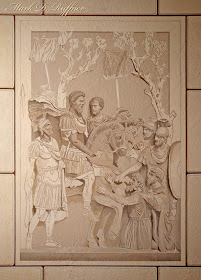My original idea for filling this wall was to create a trompe l'oeil arrangement that resembled a wall of the London residence of Sir John Soane.
 |
| musicartlondon.wordpress.com |
Not only was Soane England's premier Neoclassical architect, but he appears to have been the first person to collect architectural salvage on a large scale. Later in life, he trained young architects from his house, and his collection became an important source of learning for them. Sir John Soane had a very modern design sense, and I'm a huge fan of his work. You can read more about him in the homage I posted here.
At some point, though, I realized that to continue my masonry lines and to also paint architectural remnants would be much too busy, and that I would be better off to pick one great sculpture and give it preeminence.
I settled on this huge sculpture of barbarians kneeling before Emperor Marcus Aurelius, who is about to pardon them. The sculpture, which is nearly life-sized, is incorporated into the main staircase of the Palazzo del Conservatori, one of the Capitoline Museums. It's interesting that the emperor's gesture mirrors the statue of him that is in front of the same museum, below.
I begin by outlining the figures. All the straight lines are still in pencil because I'll go back and define them with a straightedge.
 |
| click to enlarge |
 |
| click to enlarge |
Looking towards the living room — I painted the plaque to match the coloration of the transom sculptures.
Here's a view looking back towards the kitchen.
.
























